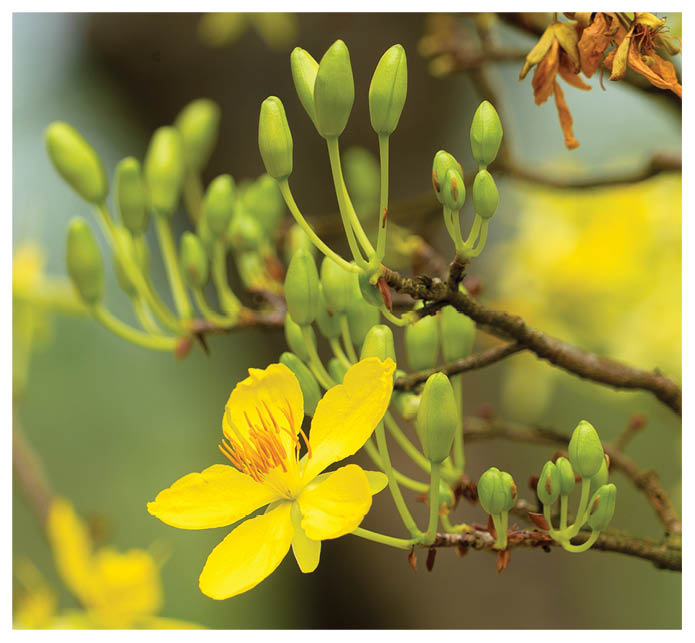And not only in the house next door but also in other neighbors and in the whole village, the yellow apricot has been found in every corner, from front yard to the alleyways. The tree is planted in front of houses, ancestral temples, pagodas or village’s communal houses.
.jpg)
Le Duan Street is bursting with the bright color of yellow apricot on every Tet celebration. Photo: H. HAI
In the hustle and bustle of the city, yellow apricot trees are grown almost everywhere. The owners of long narrow tube houses try to plant an apricot tree by making use of the narrow land strip by the gate. Those without a front yard plant the flower in a pot and place it on their balcony railing or on the terrace. Hue garden houses have one for sure, and so do the Citadel in the courtyard of Ngo Mon (the Noon Gate), The Mieu Temple and Dien Tho Cung (Dien Tho Palace). The yellow blossoms are grown throughout King tombs, temples and most commonly in pagodas. Hardly any pagoda grows no yellow apricot blossom! In the front yard of a Catholic church featuring Western architecture, a yellow apricot tree stands proud as a contributor to the blend of Western and local culture.
Not only can yellow apricot be found in houses, communal places, and pagodas but they now also offer a more pleasant front view for offices, schools, and hospitals. In some sense, the blossom has become a motif for landscape architecture in Hue city.
Yellow apricot is used for worshipping the Buddha and ancestors, but also in the living room for the owner himself and his friends. Sometimes, a beautifully-crafted apricot tree pot is not enough; there must be another natural tree branch in a vase for everyone to enjoy and appreciate the wildness of nature.
Although all yellow apricot blossom has fragrance, Hue people prefer to call their beloved flower “mai huong” (fragrant yellow apricot). Despite the bygone feudal age, Hue people keep calling the blossom “mai ngu” - the royal yellow apricot – the flower of the King. Likewise, the term “hoang mai”, which means yellow-yellow apricot in Chinese-Vietnamese, is also a favorite way Hue people treasure their land’s bloom over other regions’. Some people like to call the blossom “thanh mai” (“green blossom”) but the name indeed refers to the buds and shoots as a way to distinguish it with “hong diep mai” – “red-leaf apricot tree”, which is more commonly grown in Binh Dinh southwards. Such a modest tree can be named in various ways, and this is how Hue people show their appreciation for their local yellow apricot.

"Hoang mai” – yellow apricot tree, a locally symbolic flower of Hue city. Photo: BAO MINH
Yellow apricot is a typical flower of the Southern region, as goes a saying “pink apricot in the North and yellow apricot in the South.” in Ben Tre, people once planted a vast field of yellow apricot, and in Binh Dinh now, a few hectares of farms are still growing this flowering plant. Yet the feelings of Hue people with their own yellow apricot are still very special. The flower has always been in a close-knit relationship with Hue people, like a noble and luxurious yet familiar flower species. It can be said that yellow apricot blossom has become the flower symbol of Hue!
* * *
The provincial government has just issued a policy to build Hue into a city with four seasons of blossoms. Such an interesting and romantic idea reflects Hue style, and the forum on “Hue – the city of four seasons in blossoms. on the social network has attracted much attention of Hue people and tourists.
The provincial Institute of Socio-Economic Development Studies also held a discussion on the policy. Year-round blooming flowers and festivals will attract more tourists to Hue. Experts are expected to come up with viable solutions in order to realize the sound plan.
Though the city might be filled with thousands of year-round flowers, a symbolic flower should be chosen. Which one would be typical of Hue?
In every piece of history, the hearts and souls of local people, their daily and spiritual life have always borne all the hallmarks of yellow apricot blossom as the indigenous, symbolic flower of Hue.
Similar to the flower city of Dalat with thousands of flora species, cherry blossoms are still so typical that has given the land another name "Xu hoa dao" (The land of cherry blossom). The Netherlands is well-known for being the world’s flower field with millions of flower varieties, but the country still calls itself "The Land of Tulips". Hai Phong has been applauded as "the City of Red Flamboyant" and Sa Dec city calls itself “the City of Lotus" (as in the famous poem line “Thap Muoi is most known for Lotus”).
And Hue is "the City of Yellow Apricot". I believe that the name means so much to many Hue people, and visitors, through the story of "Hoang Mai in Hue land", will surely share the same feeling.
I envisioned on a spring day in Hue that the yellow apricot blossomed all over the city, from houses to city streets and the villages, blooming in and outside of temples, churches, offices, or schools and coating the streets, parks, and road crossings with its vibrant yellow color. Though the image of yellow apricot links with Vietnamese Tet, visitors will certainly be stunned by Hoang Mai of Hue. Isn't it the City of Hoang Mai, the way it should be praised?
By Minh Tu